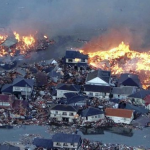Japan's Remarkable Disaster Readiness
 Only Japan could face an 8.9 scale quake and come out of it with only hundreds dead. When it comes to earthquake preparedness, the country sets the gold standard.
Only Japan could face an 8.9 scale quake and come out of it with only hundreds dead. When it comes to earthquake preparedness, the country sets the gold standard.
I grew up in Japan from Kindergarten through high school, so when I learned about the earthquake that struck the country this morning, I immediately had flashbacks to the many disaster preparedness drills I had gone through growing up. The images on the television of the aftermath of the earthquake are undoubtedly extreme and the level of damage from this natural disaster is more than any that I can remember from my lifetime. In addition to the news on television, a glance at facebook shows that many of my friends from Japan are scared as well. It seems that many phone lines are not working and I am sure the mobile phone networks are over-saturated as well. I’m also learning interesting pieces of news, apparently the roof of an ice skating rink my friends and I used to go to as a kid has collapsed.
However, only Japan could be hit with an 8.9 scale quake and come out of it with only hundreds dead. Similarly large earthquakes in less prepared countries have killed tens of thousands almost instantly. (A 7.5 earthquake in Bangladesh killed 90,000 people within minutes in 2010).
When it comes to earthquake preparedness, Japan does set the gold standard. In addition to strict building codes, a concerted effort is made to train and drill the entire population. Schools regularly practice evacuation routes, classrooms keep enough helmets in stock for all students, and reminders about where the safest place to be during a quake (under tables or in doorways) are constantly reiterated. I have vivid memories of an earthquake simulation truck that would travel around to educate people about what a large quake would feel like. The truck would be cut open to reveal a diorama of a living room. A series of springs would be activated to shake the diorama at levels up to and beyond the scale of quakes that Japan would normally be hit by.
Just as important as the civil preparedness, the security of Japan’s infrastructure is also a high priority. Its nuclear power plants have managed to be controlled despite initial concerns of a cooling problem.
Earthquakes are also excellent times to remember that Japan's architects and construction companies are some of the best and most thorough in the world. Web video is already circulating of Japanese skyscrapers swaying dramatically. This video may look shocking to the uninitiated, but it is actually a very good thing: it is much better for a building to move and sway with the earthquake as opposed to resisting it.
Undoubtedly this is the largest natural disaster to have hit Japan in decades. We will still need to follow the news to see what the final toll is, as well as to learn whether there were parts of the preparedness system that did not work properly. The most important lesson to take away is that concerted and rationally formulated mitigation methods do work in limiting the damage, even from a disaster on this scale.
UPDATE:
This explainer from Time about Japan’s evolving building codes makes a very good case for proactive and responsible government:
When disaster does hit, as it did today, Japan's buildings fare relatively well. In 1981 Japan updated its building guidelines with an eye to earthquake science. The devastating Kobe earthquake, which claimed some 5,100 lives, spurred another round of research on earthquake safety and disaster management. In 2000, the country's building codes were revised again, this time with specific requirements and mandatory checks. Even at the local level, preparedness is a priority: from 1979 to 2009, Shizuoka prefecture alone poured more than $4 billion into improving the safety of hospitals, schools and social welfare facilities.
It is rare to read about a society which responds to a disaster by learning and taking proactive steps to prevent a similar disaster in the future. Unfortunately, the last time a GOP politician spoke about disaster awareness, it was Bobby Jindal criticizing government spending on volcano monitoring. The fact that the current continuing resolution being used to fund the government also cuts funding for tsunami monitoring is a news item the GOP probably wishes it didn't have to be saddled with.
There is a strain of libertarian and conservative thought which believes that public services and regulations are not just wasteful but are inherently incapable of ever being beneficial. The Japanese experience should lead to a reevaluation of that claim.
Follow Noah on Twitter: @noahkgreen
Tweet